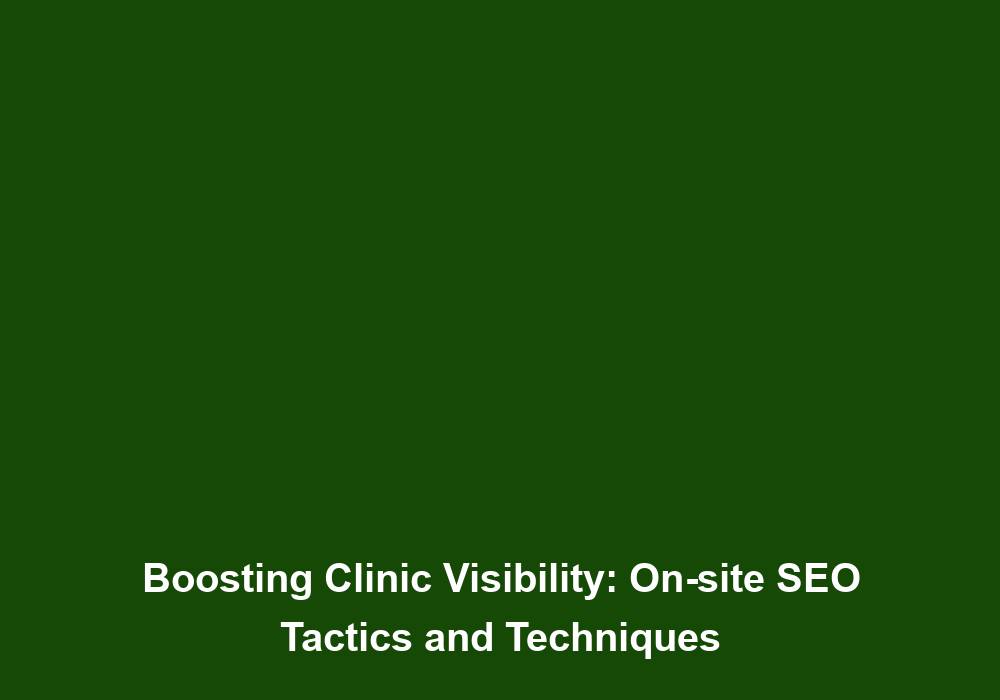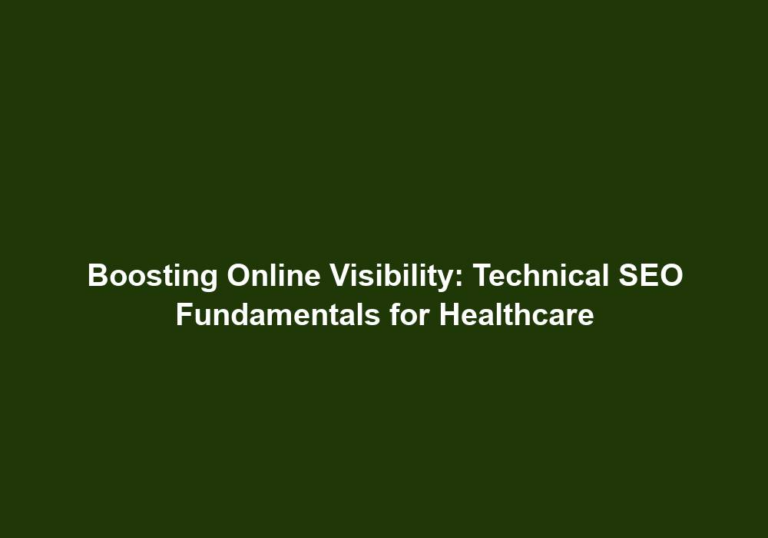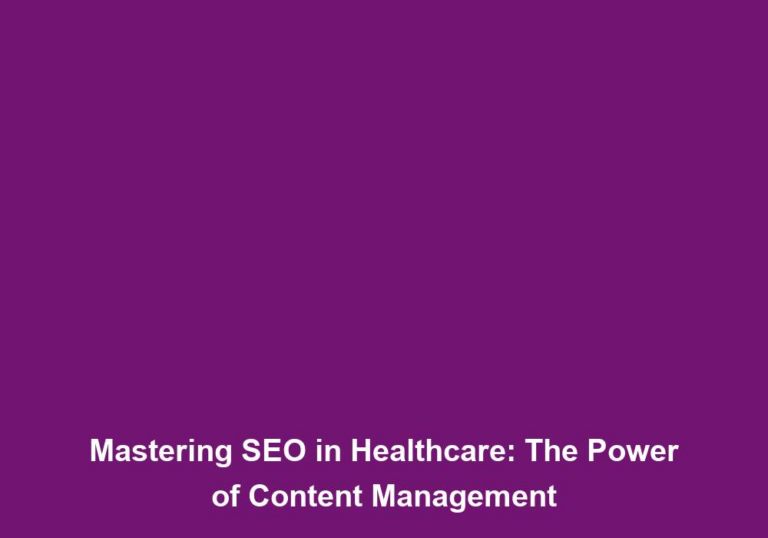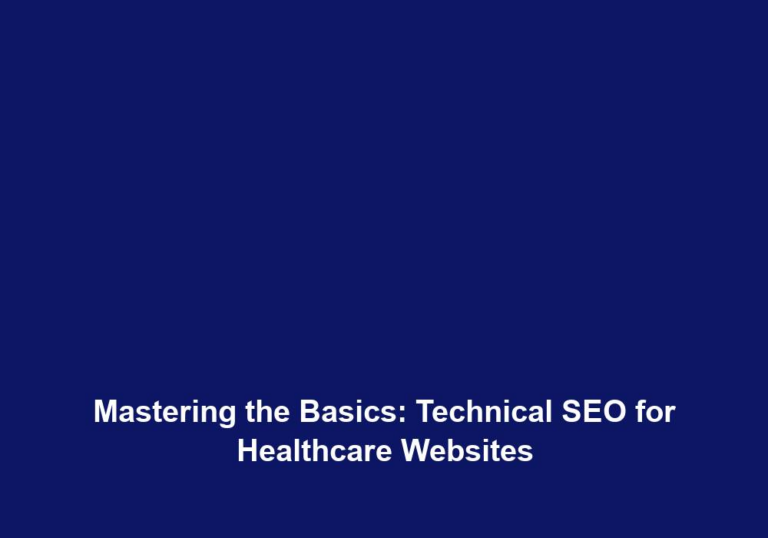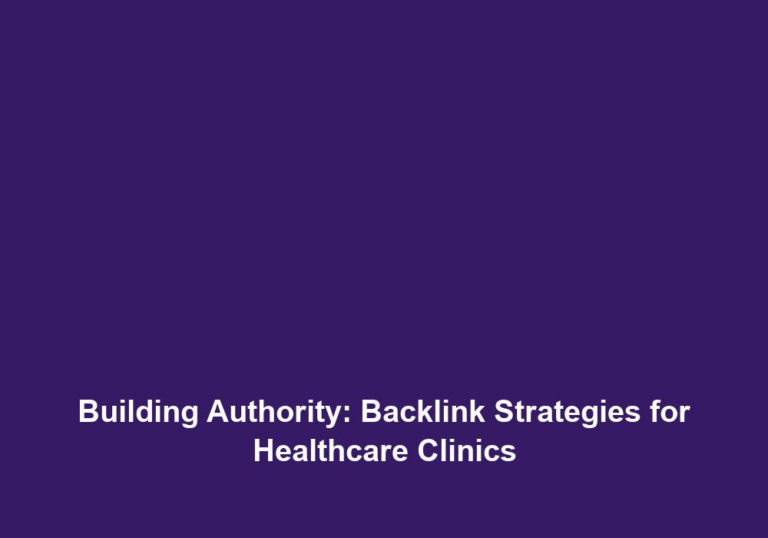Boosting Clinic Visibility: On-site SEO Tactics and Techniques
In today’s digital age, having a strong online presence is crucial for businesses to thrive, and medical clinics are no exception. With the increasing competition in the healthcare industry, it is essential for clinics to utilize effective on-site SEO tactics and techniques to boost their visibility and attract more patients. In this article, we will explore some strategies that can help clinics improve their SEO game and stand out in search engine results.
1. Optimize Your Website’s Structure and Navigation
A well-structured and easily navigable website not only enhances user experience but also plays a significant role in improving your clinic’s visibility in search engine rankings. Here are some key tips to keep in mind:
-
Create a logical hierarchy: Organize your website’s content in a hierarchical manner, with the most important pages closer to the homepage. This helps search engines understand the structure of your site better. For example, you can have a main navigation menu that includes categories like “Services,” “About Us,” and “Contact,” with subcategories and relevant pages nested under each category.
-
Use descriptive URLs: Incorporate relevant keywords in your URLs to make them more informative and search engine-friendly. For instance, instead of using www.clinicwebsite.com/page1, consider using www.clinicwebsite.com/services/dermatology. This not only helps users understand the content of the page but also improves its visibility in search engine results.
-
Implement breadcrumbs: Breadcrumbs provide users with a clear path back to the homepage and enable search engines to understand the website’s structure. They also help visitors easily navigate through your site. For example, you can display breadcrumbs like “Home > Services > Dermatology” at the top of each page, indicating the user’s current location within the site.
By optimizing your website’s structure and navigation, you create a user-friendly experience that encourages visitors to explore further and helps search engines understand your site better, ultimately improving your clinic’s visibility in search engine rankings.
2. Conduct Thorough Keyword Research
Keywords are the foundation of any successful SEO strategy. By conducting thorough keyword research, you can identify the terms and phrases potential patients are searching for. Here’s how you can optimize your clinic’s website for relevant keywords:
-
Long-tail keywords: Instead of targeting broad and highly competitive keywords like “medical clinic,” focus on long-tail keywords that are more specific and have less competition. For example, instead of targeting “pediatrician,” consider targeting “pediatrician in [your city]” or “best orthopedic surgeon near me.” This allows you to capture the attention of users who are actively searching for the services you offer.
-
Local keywords: Incorporate location-specific keywords throughout your website to capture the attention of potential patients in your area. This can include the name of the city, neighborhood, or even landmarks. For example, if your clinic is located in Los Angeles, you can optimize your content for keywords like “Los Angeles medical clinic” or “medical clinic near Hollywood.”
-
Optimize page titles and headings: Incorporate your target keywords naturally in your page titles and headings to improve their relevance and visibility in search engine results. For instance, instead of having a generic page title like “Services,” you can optimize it to say “Comprehensive Medical Services in [your city].” Similarly, use headings that include relevant keywords to provide clear and concise information to both users and search engines.
By optimizing your clinic’s website for relevant keywords, you increase the chances of appearing in search engine results when potential patients search for services related to your clinic, ultimately boosting your visibility and attracting more organic traffic.
3. Create High-Quality and Relevant Content
Content is king in the world of SEO. By creating high-quality and relevant content, you can not only attract potential patients but also enhance your website’s visibility in search engine rankings. Consider the following tips:
-
Produce informative blog posts: Regularly publish blog posts that address common health concerns, provide medical advice, or discuss recent advancements in your field. This will establish your clinic as a credible source of information and improve your chances of ranking higher in search results. For example, you can write articles on topics like “Top 10 Tips for Maintaining Heart Health” or “The Benefits of Physical Therapy for Rehabilitation.”
-
Utilize multimedia content: Incorporate images, videos, infographics, and other multimedia elements in your content to make it more engaging and shareable. This can help attract more attention and increase your website’s visibility. For instance, you can create videos showcasing different medical procedures or infographics summarizing complex medical information.
-
Optimize for voice search: With the rising popularity of voice assistants like Siri and Alexa, optimizing your content for voice search is becoming increasingly important. Consider incorporating natural language and long-tail keywords to cater to voice search queries. For example, instead of targeting the keyword “best orthopedic surgeon,” you can optimize your content to answer questions like “Who is the best orthopedic surgeon in [your city]?”
By creating high-quality and relevant content, you not only provide valuable information to your audience but also improve your website’s visibility in search engine rankings, ultimately attracting more patients to your clinic.
4. Improve Page Loading Speed
Page loading speed plays a crucial role in both user experience and search engine rankings. Slow-loading websites tend to have higher bounce rates and lower conversion rates. To enhance your clinic’s visibility, consider the following tactics:
-
Optimize image sizes: Compress and optimize images on your website without compromising their quality. Large image sizes can significantly slow down page loading speed. Use tools like Adobe Photoshop or online image compressors to reduce file sizes while maintaining visual quality.
-
Minify CSS and JavaScript files: Reduce the size of your CSS and JavaScript files by removing unnecessary characters and spaces. This can help improve page loading speed. Use tools like MinifyCSS and MinifyJS to automatically optimize your files.
-
Use caching: Implement browser caching to store static files on visitors’ devices. This reduces the number of requests made to your server and speeds up page loading. Configure caching settings in your web server or use plugins like WP Rocket or W3 Total Cache to enable caching.
By optimizing your clinic’s website for faster page loading speed, you provide a seamless browsing experience to users, improving their satisfaction and increasing the chances of conversions. Moreover, search engines favor fast-loading websites, which can positively impact your visibility in search engine rankings.
5. Ensure Mobile-Friendliness
In today’s mobile-first era, it is crucial for your clinic’s website to be mobile-friendly. With an increasing number of users accessing the internet through mobile devices, search engines prioritize mobile-friendly websites in their rankings. Consider these tips:
-
Responsive web design: Ensure that your website is responsive and adapts seamlessly to different screen sizes and resolutions. This guarantees a positive user experience across all devices. Test your website’s responsiveness using tools like Google’s Mobile-Friendly Test or Responsinator.
-
Improve mobile page speed: Optimize your website’s mobile version to improve page loading speed on smartphones and tablets. Mobile users expect fast and seamless browsing experiences. Follow the same optimization tactics mentioned in the previous section, such as optimizing image sizes and minifying CSS and JavaScript files, to enhance mobile page speed.
-
Mobile-friendly content: Format your content to be easily readable on small screens, use legible fonts, and ensure buttons and links are easy to tap. Consider using larger font sizes, ample spacing between elements, and mobile-friendly navigation menus to enhance the mobile user experience.
By ensuring your clinic’s website is mobile-friendly, you cater to the needs of mobile users and provide them with a seamless browsing experience. This not only improves user satisfaction but also increases the chances of conversions and enhances your visibility in search engine rankings.
By implementing these on-site SEO tactics and techniques, your clinic can significantly improve its visibility in search engine rankings. Remember to regularly monitor your website’s performance using analytical tools and adapt your strategies accordingly. By staying up-to-date with the latest SEO trends and continuously optimizing your website, you can attract more patients and establish your clinic as a trusted healthcare provider in your area.

